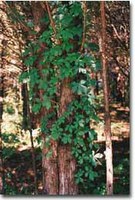Medicinal Plants 3
Compiled from Peterson Field Guide to Medicinal Plants by Steven Foster and James A. Duke
 Honey Locust
Honey Locust
(Gleditsia triacanthos)
- Native Americans used
- tea from the pods for indigestion and measles, and tea from the bark for hoarseness and sore throats.
- Current knowledge about the plant:
- Extracts from the seedpods are antibacterial, anti-fungal, and expectorant. Potentially toxic compounds exist in all parts of the plant. Experiments show that extracts from the seedpods break down red blood cells.
 Osage-Orange
Osage-Orange
(Maclura pomifera)
- Native Americans used
- a root tea as a wash for sore eyes.
- Current knowledge about the plant:
- The inedible fruits have anti-oxidant and fungicidal compounds. The latex and sap may cause dermatitis.
 Palmetto
Palmetto
(Serenoa repens)
- Native Americans used
- fruit extracts to treat prostate enlargements and inflammation, colds, asthma, coughs, and migraines.
- Current knowledge about the plant:
- It is thought to be a sedative, diuretic, and expectorant. Pharmaceutical studies suggest it may help prostate problems.
 Supplejack, Strangler vine, Rattan vine
Supplejack, Strangler vine, Rattan vine
(Berchemia scandens)
- Native Americans used
- a tea from the leaves and bark to purify blood and increase vigor, and burned stems in a tea to treat coughs.
- Current knowledge about the plant:
- No additional information
 Virginia Creeper
Virginia Creeper
(Parthenocissus quinquefolia)
- Native Americans used
- plant tea for jaundice, root tea for gonorrhea and diarrhea, and leaf tea to wash swellings and as an astringent and diuretic.
- Current knowledge about the plant:
- The leaves are toxic and the berries are also thought to be toxic.
 Yaupon Holly
Yaupon Holly
(Ilex vomitoria)
- Native Americans used
- A thick tea from the berries and leaves to invoke vomiting and diarrhea.
- Current knowledge about the plant:
- This is one of the very few native North American plants that has caffeine.
The berries are not safe to eat.